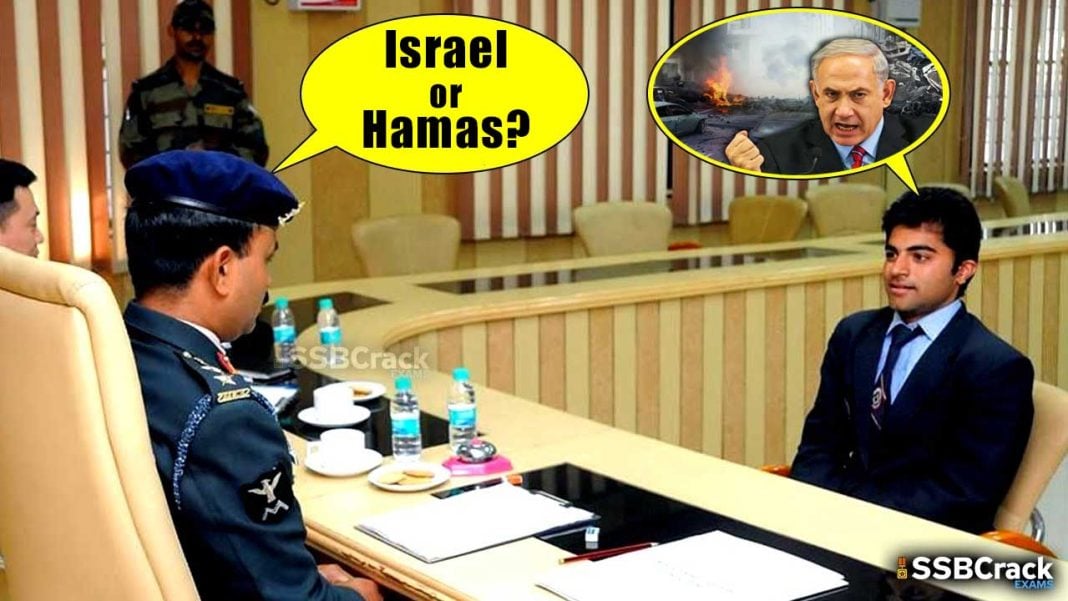Israel Palestine SSB Interview Questions
- Q: When did the modern conflict between Israelis and Palestinians begin? A: The modern conflict began in the late 19th and early 20th centuries with the rise of national movements, including Zionism and Arab nationalism. However, tensions significantly escalated following the Balfour Declaration in 1917 and the British Mandate for Palestine established after World War I.
- Q: What was the Balfour Declaration? A: The Balfour Declaration was a letter dated November 2, 1917, from British Foreign Secretary Arthur Balfour to Lord Rothschild, expressing British support for a “national home for the Jewish people” in Palestine.
- Q: What were the main outcomes of the 1947 UN Partition Plan? A: The UN Partition Plan proposed dividing British Mandate Palestine into separate Jewish and Arab states with an internationalized Jerusalem. The Jewish leadership accepted the plan, but the Arab leadership rejected it. The plan was never fully implemented, leading to the 1948 Arab-Israeli War.
- Q: What event in 1948 marked the establishment of the state of Israel? A: The State of Israel was officially proclaimed on May 14, 1948, by David Ben-Gurion, the head of the Jewish Agency.
- Q: What is the Nakba? A: The Nakba, meaning “catastrophe” in Arabic, refers to the displacement of approximately 700,000 Palestinian Arabs during the 1948 Arab-Israeli War.
- Q: Which wars followed the establishment of Israel that involved both Israel and its Arab neighbors? A: Major wars include the 1956 Suez Crisis, the 1967 Six-Day War, the 1973 Yom Kippur War, and the 1982 Lebanon War.
- Q: What territories did Israel capture during the 1967 Six-Day War? A: Israel captured the West Bank, Gaza Strip, Sinai Peninsula, and the Golan Heights.
- Q: What are the Oslo Accords? A: The Oslo Accords, signed in the early 1990s, are a set of agreements between Israel and the Palestine Liberation Organization (PLO) that established a framework for the Palestinian self-rule in the West Bank and Gaza Strip.
- Q: Who were the key signatories of the Oslo Accords? A: Yitzhak Rabin for Israel, Mahmoud Abbas for the PLO, and witnessed by U.S. President Bill Clinton.
- Q: What is the significance of the Second Intifada? A: The Second Intifada, which started in 2000, was a period of intensified Israeli-Palestinian violence. It resulted in thousands of deaths and fundamentally changed the dynamics of the conflict, leading to a decline in trust between the parties.
- Q: What is the current status of Jerusalem? A: Jerusalem remains a contentious issue. Israel considers it its undivided capital, while Palestinians envision East Jerusalem as the capital of a future Palestinian state.
- Q: Who are the key political players in Palestine today? A: The two major political factions are Fatah, which dominates the Palestinian Authority in the West Bank, and Hamas, which controls the Gaza Strip.
- Q: What is the BDS movement? A: BDS stands for Boycott, Divestment, and Sanctions. It’s a global movement that seeks to pressure Israel to change its policies toward Palestinians by boycotting Israeli goods, divesting from Israeli companies, and calling for sanctions.
- Q: How does Israel view the BDS movement? A: Israel generally views the BDS movement as an attempt to delegitimize and isolate the country. Israeli officials often describe it as anti-Semitic.
- Q: What are the Israeli settlements? A: Israeli settlements are Jewish civilian communities built on lands occupied by Israel since the 1967 Six-Day War, primarily in the West Bank, but also in East Jerusalem and the Golan Heights.
- Q: How does the international community generally view these settlements? A: The majority of the international community, including the United Nations, considers the settlements illegal under international law. However, Israel disputes this.
- Q: What is the “two-state solution”? A: The two-state solution envisions an independent State of Palestine alongside the State of Israel, living in peace and security.
- Q: What challenges have hindered the peace process in recent years? A: Some of the main challenges include disagreements over borders and the status of Jerusalem, the issue of Palestinian refugees, Israeli settlements, security concerns, internal political divisions among Palestinians, and lack of trust between the two sides.
- Q: What was the Camp David Summit in 2000? A: The Camp David Summit was a peace summit held in July 2000 between Israeli Prime Minister Ehud Barak, Palestinian leader Yasser Arafat, and U.S. President Bill Clinton. The summit aimed to address key issues but ended without an agreement.
- Q: How does the Gaza Strip differ from the West Bank in terms of governance and recent history? A: The Gaza Strip is governed by Hamas, an Islamist group, while the West Bank is administered by the Palestinian Authority dominated by Fatah. Hamas took control of Gaza in 2007 following a conflict with Fatah.
- Q: What is the Palestinian Right of Return? A: The Palestinian Right of Return refers to the belief that Palestinian refugees, and their descendants, should be allowed to return to the homes and lands they were displaced from in 1948.
- Q: What is the Iron Dome? A: The Iron Dome is an air defense system developed by Israel to intercept and destroy short-range rockets and artillery shells fired from distances of 4km to 70km.
- Q: Who was Yitzhak Rabin and what was his significance to the peace process? A: Yitzhak Rabin was an Israeli Prime Minister who played a pivotal role in the peace process, notably with the signing of the Oslo Accords. He was assassinated in 1995 by an Israeli extremist opposed to his peace initiatives.
- Q: What is the role of the Quartet in the Israeli-Palestinian peace process? A: The Quartet comprises the United Nations, the United States, the European Union, and Russia. Established in 2002, it seeks a peaceful resolution to the conflict based on international law and previous agreements.
- Q: What are the “Green Line” and the “pre-1967 borders”? A: The “Green Line” refers to the 1949 Armistice Line established after the 1948 Arab-Israeli war. It’s often referred to as the “pre-1967 borders” because it demarcated the boundaries before the 1967 Six-Day War.
- Q: What is the significance of the Temple Mount/Haram al-Sharif in Jerusalem? A: The Temple Mount, known to Muslims as Haram al-Sharif, is a religious site of immense significance to both Jews and Muslims. It’s believed to be the location of ancient Jewish temples and currently houses the Al-Aqsa Mosque and the Dome of the Rock.
- Q: What was the 2005 Israeli disengagement from Gaza? A: In 2005, Israel unilaterally dismantled all Israeli settlements in the Gaza Strip and withdrew its military forces, effectively ending its direct occupation of the territory.
- Q: Who was Golda Meir and what was her role in the Israeli-Palestinian narrative? A: Golda Meir was the fourth Prime Minister of Israel. She held office during the 1973 Yom Kippur War and was known for her tough stance against concessions to the Arab states and Palestinians.
- Q: What are the main sources of tension in Hebron? A: Hebron is home to several hundred Israeli settlers living in close proximity to a much larger Palestinian population, leading to frequent clashes. The presence of the Ibrahimi Mosque/Tomb of the Patriarchs, sacred to both Jews and Muslims, further complicates the situation.
- Q: How has the Great March of Return in Gaza affected Israeli-Palestinian relations? A: The Great March of Return, which began in 2018, consisted of mass protests along the Gaza-Israel border. The resulting violence and casualties deepened hostilities and further strained relations.
- Q: What role has Egypt played in the Israeli-Palestinian conflict? A: Egypt, historically an adversary of Israel, became the first Arab country to recognize Israel and sign a peace treaty in 1979. Since then, it has often played a mediatory role, particularly between Israel and Hamas in Gaza.
- Q: Who was Theodor Herzl? A: Theodor Herzl was a Jewish journalist and the founder of modern political Zionism. He envisioned the establishment of a Jewish state in Palestine.
- Q: What is the PLO? A: The PLO, or Palestine Liberation Organization, established in 1964, aimed to liberate Palestine and represented Palestinians in political matters. It was recognized by Israel and the U.S. in the 1990s as representing the Palestinian people.
The Israel-Palestine-Hamas situation is a microcosm of larger themes: nationalism, religion, territorial disputes, and post-colonial geopolitical maneuvers. For defence aspirants, understanding this conflict is not just about grasping its history and current events but also about appreciating the complex interplay of forces at work. By anticipating questions and framing informed, balanced answers, aspirants will be better prepared to tackle this topic during the SSB Interview.






Vudesh